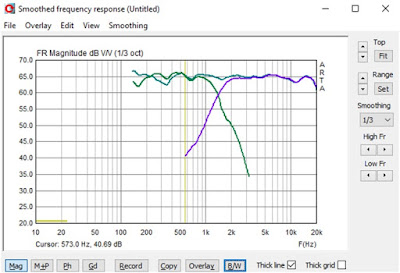Continuing from my previous blog post on Speaker No. 1159 I continue my comparison against a non-horn loaded test baffle. I compare distortion sweeps at high SPL and look at why 1159 is able to accommodate a very simple first order high pass filter for the tweeter where this is simply impossible with the non-horn loaded test baffle.
Below is the raw frequency response for 1159's horn loaded tweeter.
|
Raw Frequency Response for 1159's horn loaded tweeter |
Below is the electrical schematic for the 1159's passive high pass crossover. (L-pad omitted)
|
First order high pass filter schematic for 1159 |
If we implement the following simple high pass filter we get the following response...
|
1159 frequency response with first order high pass filter |
What should be a 5kHz theoretical crossover point is actually 1.5kHz! Typically a 1st order crossover is not advisable due to limited power handling capacity near the crossover region. However we shall see that this is not the case due to the horn's increased sensitivity providing a full 9dB more headroom.
For testing purposes I used my MiniDSP to setup 1159 in an active configuration. I replicated the passive crossover slope to achieved similar response curves.
|
5kHz BW 6dB/Oct High Pass on MiniDSP |
I was then able to get the following measured response with the MiniDSP without using any PEQ or delay.
|
1159 frequency response overlay with MiniDSP (No PEQ applied). |
I then conducted distortion sweeps by incrementally increasing output until distortion started to spike. I decided to directly compare 1159 with my non-horn loaded test baffle which had a 1.5kHz 24dB/LR filter while the 1159 baffle used a 6dB/BW filter as mentioned earlier.
Click HERE for a PDF of the data presented below.
Distortion sweeps continued up to 100dB SPL...
Click HERE for the PDF of the data presented below.
By 100dB the non-horn loaded baffle was exhibiting 5% distortion at the crossover point while 1159 remained below 1%.
I then increased the crossover point on the non-horn baffle to 2.5kHz. The distortion was still above 1% even with this very high crossover point (see below).
Click HERE for the PDF version of the data presented below.
Advantages of 1st order crossover...
Below is a comparison between the measured phase response of the two crossover topologies. Please note the green line is not correct in the below graphs since the gating was centered at the peak of the initial impulse response which is required to achieve the correct phase response sweep.
|
Phase response comparison between 24dB/LR crossover (Left) versus 6dB/BW (Right) |
Conclusion
I was able to show that the 1159 speaker is able to accommodate a very simple first order filter by showing that it is capable of achieving 100dB SPL@1meter while remaining below 1% distortion. If we use 0.50% as a distortion threshold limit then the speakers would be capable of the following SPL output...
Maximum SPL of each Speaker
- 1159 Speaker: 90dB SPL@1 meter
- Non-horn loaded Speaker: 80dB SPL@1 meter
